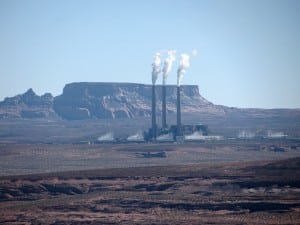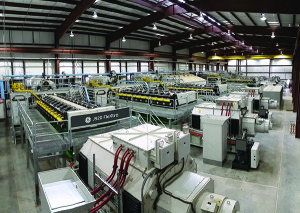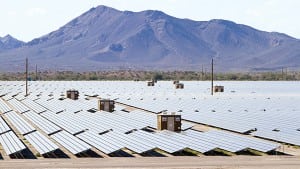Tucson Electric Power
-
Nuclear
Arizona Utilities Announce Effort to Add More In-State Nuclear Power
Arizona’s three major electric power utilities said they will collaborate to explore adding more nuclear power generation in the state, possibly placing small modular reactors (SMRs) or building large reactor projects at the locations of retiring coal-fired power plants. Arizona Public Service (APS), Salt River Project (SRP), and Tucson Electric Power (TEP) on Feb. 5 […]
-
Electrification
POWER Notebook: New Projects For Energy Storage, Community Solar, Electric Buses; Google Announces PPA
An Arizona utility plans to build a battery energy storage system (BESS) that will help it store more of the region’s abundant solar energy, enabling the power to be used after the sun goes down. Tucson Electric Power (TEP) in early October said it plans to start operating what would be the largest energy storage […]
-
Press Releases
Two more utilities join the Western Energy Imbalance Market
FOLSOM, Calif. (March 2, 2022) – Avista Utilities and Tacoma Power, two utilities serving a combined 600,000 electric customers in the Pacific Northwest, are the newest members of the Western Energy Imbalance Market (WEIM), with both beginning their participation today. Avista Utilities, which serves more than 400,000 electric customers in Washington and Idaho, and Tacoma […]
-
News
Power Industry Weighs Impacts of Coronavirus
Utilities and power generators worldwide are altering their business practices and developing strategies for dealing with the COVID-19 pandemic. It’s particularly critical for the power industry, as a reliable supply of electricity is essential to prevent even more economic disruption. The U.S. Department of Homeland Security (DHS) lists utilities among the 16 industries that the […]
-
Coal
Companies End Effort to Buy Navajo Generating Station
The companies negotiating to purchase the largest coal-fired power plant in the southwestern U.S. have ended their pursuit, which means the 2,250-MW Navajo Generating Station (NGS) near Page, Arizona, remains scheduled to close by year-end 2019. Avenue Capital, a New York-based global investment firm focused on distressed assets, and Chicago-based Middle River Power on September […]
-
Coal
Potential Navajo Station Operator—Less Capacity Equals More Profit
The possible new operator of the largest coal-fired power plant in the western U.S. told Arizona regulators this week the company would run the Navajo Generating Station (NGS) at less than half its installed generation capacity in order to maintain profitability. An official for Illinois-based Middle River Power (MRP) also said the plant would operate […]
-
Coal
Navajo Nation Negotiating Sale of West’s Largest Coal Plant
The Navajo Nation on July 12 said it has identified a potential buyer for the 2,250-MW Navajo Generating Station (NGS) in Arizona, the largest coal-fired power plant in the western U.S. The Navajo Nation Council, in a joint news release with the Navajo Nation’s Office of the President and Vice President, said the Hopi Tribe […]
-
Coal
Chicago Company Preparing Offer for Navajo Generating Station
A suburban Chicago-based energy company executive on June 7 told Arizona officials his group is putting together a proposal to purchase the Navajo Generating Station (NGS), the largest coal-fired power plant in the western U.S. The plant’s current owners have said they will close the 2,250-MW facility by year-end 2019 unless a buyer is found. […]
-
Renewables
West’s Largest Coal Plant Could Get a Lifeline
The Navajo Generating Station (NGS) in Arizona is scheduled to close by year-end 2019, but intervention by the federal government could keep the West’s largest coal-fired power plant operating. At the same time, more than 300 of the plant’s workers, along with family members, union representatives and tribal leaders, held a rally in Phoenix on […]
-
Renewables
Quick Starts, High Efficiency, Grid Balance — Engines on an Up Cycle
The growth of renewable energy, and with it the need for reliable backup generation, along with the increase in combined heat and power applications, is contributing to a rise in the use of reciprocating
-
Legal & Regulatory
Regulators, Lawmakers Spar Over Arizona Renewable Mandates
State regulators in Arizona want the state’s investor-owned utilities to source more of their electricity from renewable sources, and develop more energy storage options, rather than rely on new natural gas-fired generation in the future. State senators, however, voted March 14 to give utilities a way to get around any voter-supported mandates for renewables. The […]
-
Press Releases
Greensmith Energy Partners with E.ON Climate and Renewables and Tucson Electric Power for a 10 Megawatt Energy Storage Project in Arizona
HERNDON, Va.–(BUSINESS WIRE)–Greensmith Energy, the leader in energy storage software and integration services, announced it will partner with E.ON Climate and Renewables and Tucson Electric Power (TEP) to design and deliver a grid-scale energy storage system located at the University of Arizona Science and Technology Park southeast of Tucson. The 10 megawatt (MW) site will […]
-
Press Releases
E.ON and Tucson Electric Power Sign Iron Horse Battery Energy Storage Agreement
CHICAGO, July 25, 2016 /PRNewswire/ — E.ON Climate & Renewables North America, LLC (E.ON) today announced it signed an agreement with Tucson Electric Power (TEP) to provide frequency response and voltage control from a grid-scale, 10 megawatt (MW) battery energy storage facility with a 2 MW solar array. The Iron Horse Battery Energy Storage Project will […]







